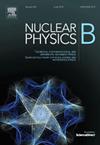Particle-antiparticle oscillation modes crossing horizon: Baryogenesis and dark-matter waves
IF 2.5
3区 物理与天体物理
Q2 PHYSICS, PARTICLES & FIELDS
引用次数: 0
Abstract
Quantum massive particle and antiparticle pair production and oscillation during reheating result in a holographic and massive pair plasma state. Perturbations in the densities of particles and antiparticles within this plasma form acoustic waves, characterized by symmetric and asymmetric density contrasts. By deriving the acoustic wave equations and identifying the frequencies of the lowest-lying perturbation modes (with zero wave number), the study shows that the wavelengths of these modes, when compared with the horizon size, suggest the possibility of superhorizon crossing during reheating. This crossing leads to particle-antiparticle asymmetry observable by an observer inside the horizon. The decay of massive particles and antiparticles into baryons generates a net baryon number, potentially explaining baryogenesis. The calculated baryon number-to-entropy ratio aligns with observational data. This crossing also accounts for dark matter particle-antiparticle asymmetry in the present Universe. The study also explores perturbation modes with nonzero wave numbers, representing dark-matter acoustic waves. These modes exited the horizon and re-entered after recombination, potentially imprinting on the matter power spectrum at large length scales and influencing the formation of large-scale structures and galaxies.
求助全文
约1分钟内获得全文
求助全文
来源期刊

Nuclear Physics B
物理-物理:粒子与场物理
CiteScore
5.50
自引率
7.10%
发文量
302
审稿时长
1 months
期刊介绍:
Nuclear Physics B focuses on the domain of high energy physics, quantum field theory, statistical systems, and mathematical physics, and includes four main sections: high energy physics - phenomenology, high energy physics - theory, high energy physics - experiment, and quantum field theory, statistical systems, and mathematical physics. The emphasis is on original research papers (Frontiers Articles or Full Length Articles), but Review Articles are also welcome.
 求助内容:
求助内容: 应助结果提醒方式:
应助结果提醒方式:


